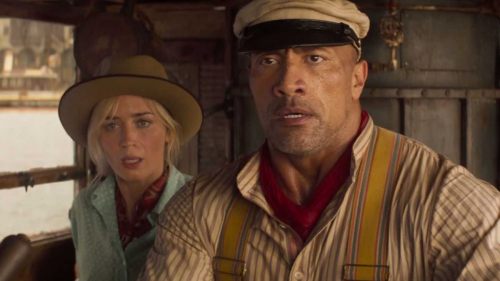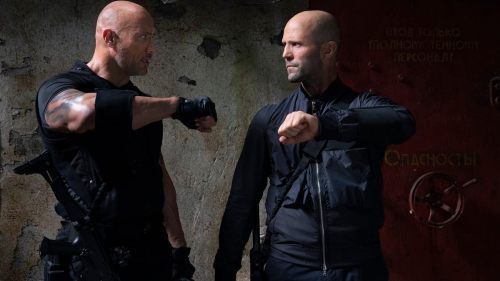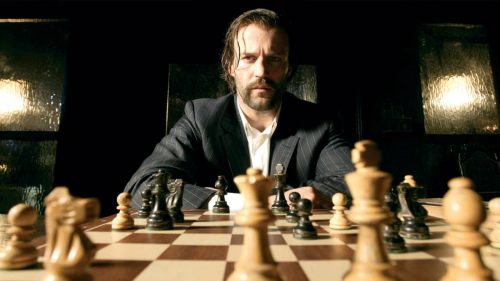HOBBS & SHAW Review: Big Loud Dumb Fun
Time was, not so long ago, when the descriptor “comic-book” served as derogatory shorthand for action, sci-fi or fantasy films in which spectacle was prioritized and character and storytelling concerns were left in the dust. These days, with some (if not all) of the Marvel and DC output offering up a healthy amount of those latter qualities in the midst of the special effects, that phrase should be reconsidered—but not abandoned, since it applies perfectly to Hobbs & Shaw. Though spun off from the Fast and the Furious franchise and not a four-color printed source, it’s a “comic-book” movie through and through—one set in the ostensible real world with flesh-and-blood heroes, but bearing no relation to any recognizable rules of reality, or common sense.
That’s not really a surprise, as the franchise has been driving in this direction through the last several installments, which shifted the emphasis from street-level pursuits to an ever-wider international canvas with way-over-the-top stunt blowouts (epitomized by the endless-runway sequence in Fast & Furious 6). There’s even a superpowered human in the Hobbs & Shaw mix: Brixton (Idris Elba), the villain who’s been bioengineered to become, in his own words, “black Superman.” He’s after a MacGuffin that could prove to be Kryptonite for the rest of the world: a virus that can be programmed to attack any DNA sequence, and has been engineered by a malevolent organization called Eteon as part of a scheme to “save” the human race by killing off its weakest members, i.e. pretty much all of us. This plot doesn’t stand up to basic scrutiny any more than the similar one in Godzilla: King of the Monsters, but it does serve the purpose of motivating the DSS and CIA to press Luke Hobbs (Dwayne Johnson) and Deckard Shaw (Jason Statham) back into service together to stop it.
Needless to say, neither one is thrilled with this arrangement; their initial reaction cheekily tweaks the MPAA’s one-f-bomb-per-PG-13 rule. But these two bad-asses will have to put aside their differences and past grievances (#JusticeforHan will have to wait for the next official Furious film, perhaps) to stop Brixton from seizing the virus. Complicating matters: MI6 agent Hattie (Vanessa Kirby) has injected the plague into her own self in an attempt to keep it out of enemy hands, and there’s only a limited amount of time to remove it before she and then the general population succumbs. Complicating matters further: She’s Shaw’s estranged sister, which lends a more personal element to the mission—and beefs up the tension between Hobbs and Shaw, especially when Hattie begins sparking with the hunk of man her brother’s been reluctantly paired with.
That tension is expressed in a string of trash talk between the two leads, courtesy of series-regular scripter Chris Morgan and newcomer Drew Pearce (Iron Man 3), that’s sometimes pretty funny. If you’re going to make a movie that hinges on the charisma of a couple of tough guys who can win over an audience while kicking lots of ass and blowing lots of stuff up, you can’t do much better than Johnson and Statham. Both latecomers to the Fast and the Furious world, they’ve become the most engaging members of the ensemble, and both have the proper over-the-top spirit to carry Hobbs & Show through its outlandish extremes. Similarly, director David Leitch’s experience on the likes of John Wick and Deadpool 2 makes him perfect for this franchise, and he orchestrates the big-bigger-biggest human and automotive mayhem with skill, culminating in a completely ridiculous, and ridiculously entertaining, final setpiece.
Fully enjoying all this requires turning off the logic centers of your brain, since Hobbs & Shaw is the kind of film that sets ticking-clock limits (those super-guns can only be disabled for six minutes!) and then flagrantly ignores them. The finale is set in a Samoa where the weather turns on a dime from dark to sunny to stormy, depending on the atmospheric needs of a particular scene. (How the characters get there involves one of a pair of unbilled extended cameos that won’t be revealed here; suffice to say that both the director and one of the stars called in a friend.) This trip also belatedly returns the movie to the themes of family that have underpinned and provided some of the appeal in the past Fast and Furiouses, and that work the same way here. Basically, if you enjoyed the last few of these films, you’ll enjoy this one too, and it’s likely you’ll see this offshoot generate sequels of its own. A concluding scene clearly indicates that we haven’t seen (or more accurately heard) the last of one of the baddies—although, true to the film’s take-nothing-seriously spirit, the three (!) mid- and post-credits bits are concerned with running jokes rather than universe-building.



